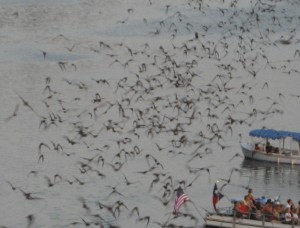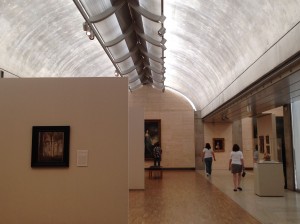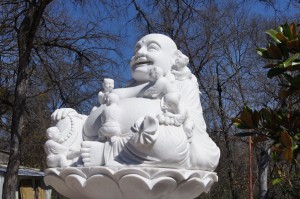Now is a great time to visit Austin and see some of the city’s unique, seasonal visitors. In fact, the city’s population swells by an additional 750,000 between March and October. It’s not a hoard of legislators or even lobbyists besieging the capital. These seasonal visitors  are Mexican Free Tail bats, and their home of choice is beneath the Congress Avenue Bridge, just blocks from the Texas State Capital.
are Mexican Free Tail bats, and their home of choice is beneath the Congress Avenue Bridge, just blocks from the Texas State Capital.
Bat Bridge
The winged mammals took up residence after a bridge modification in the early 1980s. The bats fit nicely into slots cut underneath the bridge. Each spring, pregnant bats arrive in March to give birth. According to Bat Conservation International, Congress Avenue Bridge is one of the largest urban bat nurseries in the United States. The bridge can support as many as 500 bats per square foot!
Bat Moms and Pups
At dusk, the mother bats leave their individual pups up under the bridge and fly off to hunt. It’s this dusk flight that draws a different type of animal — tourists — to Congress Bridge. To avoid predators, the bat colony begins its nightly hunt in mass. As the bats emerge, they form an aerial river of winged mammals flowing out from under the bridge. The bats head east to forage on bugs, nightly consuming 5 to 15 tons of insects helping to keep mosquito populations in check. After an evening of bug hunting, mom returns to the bridge. She finds her pup by its unique sound and smell.
Around July, the young bats join mom in the nightly flight. It’s a perilous endeavor for the little critters. Aerodynamically, the bats begin flight by dropping from their perch. If grounded, they are not able to get airborne again. Each night several of the little bats plop into Town Lake. The lucky ones get plucked out of the water with nets by the tour boats and placed on the bridge pilings. Here they can climb high enough to drop and attempt flight again.
Bat Viewing Tips. There are several ways to view the Congress Bridge bat colony. Capital Cruises Austin offers nightly boat excursions. This is a great way to see the bats up close. Reservations are required and can be made at 512-480-9264. You can see the bats from land, too. The east side of Congress Bridge just before dusk is an ideal viewing location. You can also see the bats quite nicely along the Ann and Ray Butler Hike and Bike trail just below the Four Seasons hotel. Bat Conservation International’s website at batcon.org posts current time frames for the bats’ nightly appearances.


